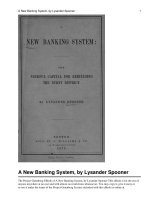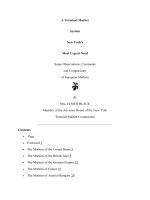A Terminal Market System, by Mrs. Elmer Black pdf
Bạn đang xem bản rút gọn của tài liệu. Xem và tải ngay bản đầy đủ của tài liệu tại đây (1.52 MB, 123 trang )
The Project Gutenberg EBook of A Terminal
Market System, by Mrs. Elmer Black
This eBook is for the use of anyone
anywhere at no cost and with
almost no restrictions whatsoever. You may
copy it, give it away or
re-use it under the terms of the Project
Gutenberg License included
with this eBook or online at
www.gutenberg.net
Title: A Terminal Market System
New York's Most Urgent Need; Some
Observations, Comments,
and Comparisons of European Markets
Author: Mrs. Elmer Black
Release Date: April 22, 2009 [EBook
#28575]
Language: English
*** START OF THIS PROJECT GUTENBERG EBOOK
A TERMINAL MARKET SYSTEM ***
Produced by Diane Monico and The Online
Distributed
Proofreading Team at
(This file was
produced from images generously made
available by The
Internet Archive/American Libraries.)
Copyright, 1912, by Mrs. Elmer Black
A Terminal
Market
System
New York's
Most Urgent Need
Some Observations,
Comments
and Comparisons
of European Markets
By
Mrs. ELMER BLACK
Member of the Advisory Board of the New York
Terminal Market Commission
Contents
Foreword
The Markets of the United
States
The Markets of the British
Isles
The Markets of the German
Empire
The Markets of France
The Markets of Austria-
Hungary
Page
3
5
5
13
23
29
The Markets of Holland
The Markets of Belgium
Comments
30
30
31
Illustrations
Covent Garden Market
Smithfield in the Olden Days
Delivering Meat at
Smithfield Today
Inside Smithfield Market
Billingsgate Fish Market,
London
Berlin's Terminal Market
Interior of the Berlin Central
Market
Ground Plan of the Munich
6
8
8
10
12
14
16
18
Market
Munich's Modern Terminal
Market
The Paris Halles, exterior
view
The Paris Halles; Keen
Morning Buyers
A Drastic Inspection
18
20
24
26
28
Foreword
In the belief that the establishment of a
first-class Terminal Market system,
worthy of twentieth century requirements,
is a matter of vital importance to every
family in New York, I have spent
considerable time during the past few
months investigating markets on both sides
of the Atlantic.
As a result I am more than ever conscious
of the need for an enlightened public
opinion to support the efforts of the
Terminal Market Commission to secure
this benefit for our community. I am
convinced that our fellow-citizens will
approve the requisite expenditure once
they are roused to a realization of the
inadequacy of our food-distributing
centers.
In the hope that my investigations may aid
in the accomplishment of this reform, I
have prepared these observations,
comments and comparisons.
It is true that the problem of the high cost
of living is afflicting the old lands of
Europe, the newer countries like New
Zealand, as well as our own wide
territories of the United States. The causes
vary, according to local conditions; but
everywhere it is agreed that a potent force
for the amelioration of the condition of the
consumers is found in the establishment of
efficient Terminal Markets under
municipal control for all progressive
cities. With wise administration, stringent
inspection and sound safeguards, these
municipal markets benefit both producers
and consumers. They eliminate
considerable intermediate expense, delay
and confusion. Last but not least they
return a profit to the city treasury.
It is because our New York markets
achieve none of these beneficent results
that I issue this plea for the establishment
of an adequate Terminal Market system. I
appeal to all who have the welfare of their
city at heart to add the force of their
opinion to the accomplishment of this
civic improvement.
(MRS. ELMER BLACK)
United States
NEW YORK, with over 5,000,000
inhabitants, has no effective market
system. The buildings are out of repair,
there is little or no organization, and the
superintendent has testified before the
New York Food Investigation
Commission (March 12, 1912) that on
their administration last year there was a
loss to the city treasury of $80,000. To
that must be added due consideration of
the inconvenience to the consumers,
producers and dealers, and the extra cost
of handling entailed by the lack of modern
market methods. The city has almost
quadrupled its population in a generation,
but the markets remain about as they were.
Many other cities in the United States not
only testify to the value of municipal
markets as a means for lowering prices to
the consumer, but so guard their interests
as to provide a very different balance
sheet.
Boston has a profit on its markets of
$60,000, Baltimore $50,000, New
Orleans $79,000, Buffalo $44,000,
Cleveland (Ohio) $27,507, Washington
(D. C.) $7,000, Nashville (Tenn.) $8,200,
Indianapolis $17,220, Rochester (N. Y.)
$4,721, and St. Paul (Minn.) $4,085.
If the following facts concerning
municipal markets are studied, also, it
will be seen that no city in any way
comparable to New York fails to make the
municipal markets yield advantages both
to the community and the city treasury.
The British Isles
LONDON naturally serves as a starting
point for a tour of European investigation.
The British capital has, indeed, features
that render it comparable in a peculiar
degree with New York. The population of
both, including their outer ring of suburbs,
is over five millions. In each case there is
access to the open sea by means of a noble
waterway over which passes the
commerce of the seven seas. Railroads
supplement the water-borne cargoes with
home-grown produce, fresh from the farms
for the use of urban kitchens.
London's markets do not afford the
unbroken example of municipal control
that they would if a new system were to be
created at the present day. Precedent
looms large in British administration and
even now there are only two ways of
establishing a market—by Parliamentary
authority and Royal Charter. King Henry
III covenanted by charter with the City of
London not to grant permission to anyone
else to set up a market within a radius of
seven miles of the Guildhall, and this
privilege was subsequently confirmed by
a charter granted by Edward III in 1326.
But of late years the City Corporation has
waived its rights and allowed markets to
be established in various districts
wherever a real necessity has been shown
to exist. In fact the markets of London
have grown with the city, keeping pace
with its requirements.
COVENT GARDEN MARKET
The Morning Rush of Farm and Garden Produce for London
Consumers.
There remains, however, the fact that
certain Corporation markets and Covent
Garden market serve as great wholesale
terminals, connected more or less
unofficially with the numerous local
markets in the outlying districts.
Chief among the Corporation markets is
Smithfield, covering about eight acres,
and costing altogether $1,940,000. There
are to be found wholesale meat, poultry
and provision markets, with sections for
the sale, wholesale and retail, of
vegetables and fish. In the last twenty
years the development of cold storage
processes has lowered the quantity of
home-killed meat and remarkably
increased the importation of refrigerated
supplies. Last year the wholesale market
disposed of 433,723 tons of meat, of
which 77.2 per cent came from overseas.
Ten years ago the United States supplied
41 per cent of the Smithfield meat, but
now these supplies have fallen off
enormously and the last report of the
Markets Committee says: "The United
States, in particular for domestic needs, is
within measurable distance of becoming a
competitor with England for the output of
South America." South America and
Australasia are, indeed, the chief
producers today for the British market.
This has developed a great cold storage
business in London. All told London can
accommodate 3,032,000 carcases of
mutton, reckoning each carcase at 36
pounds. Over 41 per cent of England's
imported meat passes through Smithfield,
and railroad access is arranged to the
heart of the market. The Great Northern
Railway Company has a lease from the
corporation on 100,000 feet of basement
works under the meat market, with
hydraulic lifts to the level of the market
hall, and inclined roadways for vehicular
traffic.
Most of the tenants at Smithfield are
commission salesmen, who pay weekly
rents for their shops and stalls at space
rates, all the fittings being supplied. Last
year these rents brought in $427,920.
There is a toll of a farthing on every 21
pounds of meat sold, which together with
cold storage, weighing and other charges
amounted in the same period to $241,635.
The meat sales are entirely wholesale,
except on Saturday afternoons, when there
is a retail "People's Market," where
thousands of the very poor buy cheap
joints.
OLDEN DAYS
From an Old Print Dated 1810.
SMITHFIELD TODAY









